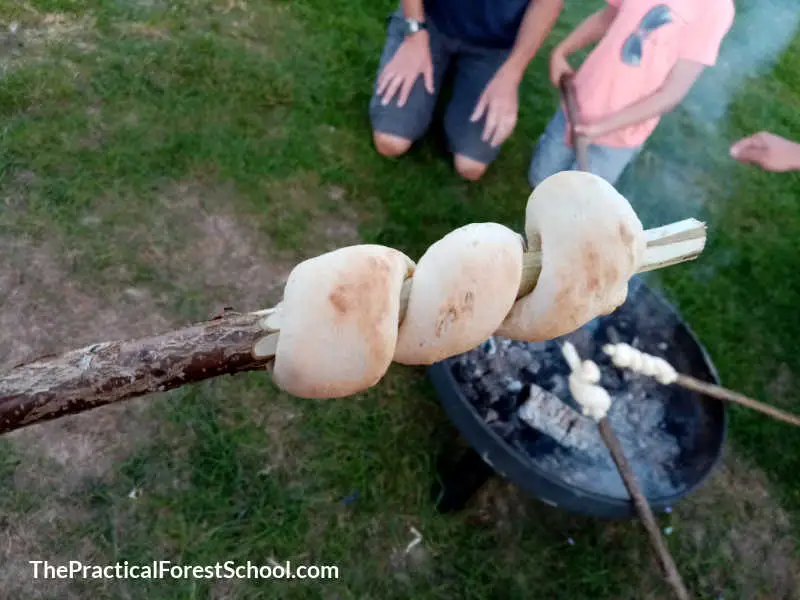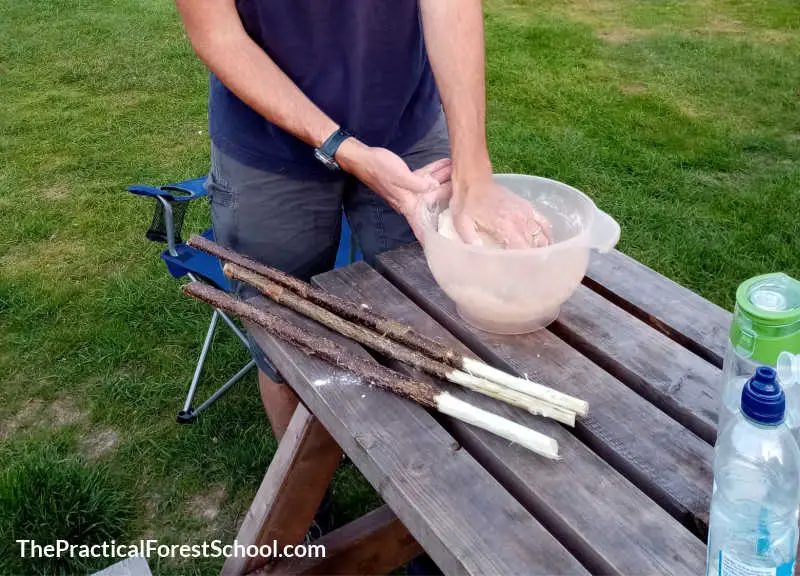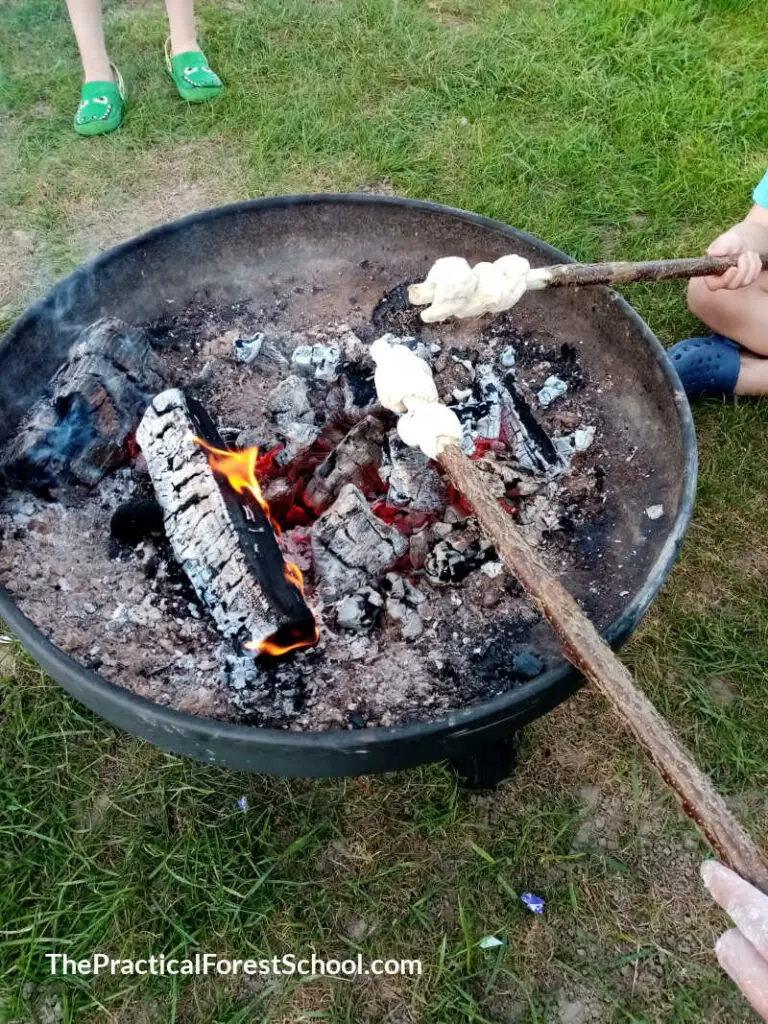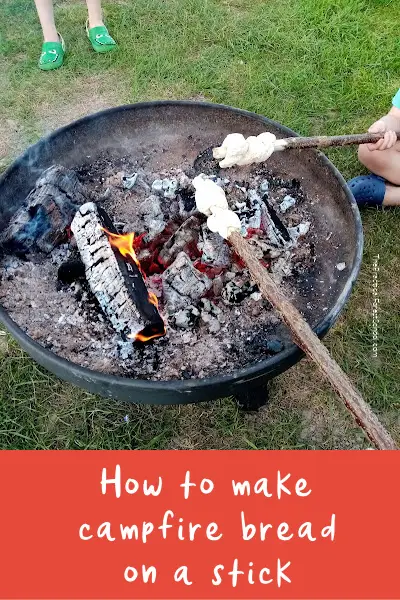How to make easy campfire bread on a stick
Wondering how to make campfire bread on a stick? We have a super simple, 3-ingredient recipe that works every time.

What is damper bread?
Proper damper bread is an Australian unleavened bread traditionally made on the coals of the fire by Indigenous and Aboriginal people, and the early settlers.
Today, damper bread in the UK is a bit of a shorthand for bread cooked on a stick over a campfire, but the two things are quite different. Campfire bread is pushed onto or wrapped around a stick, whereas the traditional Australian damper bread is a soda bread-style loaf.
Our campfire bread is easy to make around an open fire because the bread dough doesn’t include yeast and there is no rising time. Plus anything cooked on a stick is fun!
Ingredients
For approx. 10-15 thick bread wraps or more on thinner sticks.
- 600g (4 cups) self-raising flour
- 500 ml (approx. 2 cups) water (or milk/dairy free milk) – you might not need all of this
- Two pinches of salt
- Jam, sugar, or other toppings
You’ll also need:
- Large mixing bowl
- Wooden spoon
- Greenwood sticks – strip the bark off the part that the dough touches (use a knife for this). The sticks need to be about as long as an adult’s arm to allow them to reach the fire easily.
How to make bread on a stick on the fire
Step 1
Put the dry ingredients, bread and salt, in the bowl and mix them up.
Step 2
Add the water, milk or dairy free milk.
Add it a little at a time, stirring as you go. Eventually it will get too difficult to mix using the spoon and you’ll have to get your hands in there!
Knead the dough until it looks and feels like dough. It will be stretchy and soft.

Step 3
Take a large-ish golf-ball sized piece of dough. Roll it between your palms into a sausage.
Now you have two choices.
You can either:
- Flatten the sausage slightly and wrap it around the stick in a spiral; or
- Push the stick into the sausage. If you choose this option, I would lay the stick along the sausage and push it down, then work the dough around the stick. Don’t try and poke the stick in the end of the sausage as the dough isn’t tough enough to make this easy.
Either way, make sure the stick is covered so it doesn’t burn.

Step 4
Cook the dough.
Use the embers of the fire and turn the dough regularly, at least once every five minutes. The campfire bread is OK to leave if you have a way to prop the sticks up so they don’t fall into the embers. Just keep checking back regularly and turning the bread.
It will take about 15 minutes to cook all the way through, and it will puff up a bit too.
15 minutes is a long time to wait. In our experience, even junior school kids get bored of waiting. Find a way to prop the sticks up so they can go off and do something else, coming back regularly to turn their stick and check on their campfire bread.
Obviously, as a point of safety, someone needs to stay by the fire. This is definitely a forest school activity to do with more than one adult in attendance!
Step 5
Eat!
My preference is to peel the bread off the stick and eat it with jam, but you can offer a range of other toppings:
- Chocolate spread (nut-free if you are in a setting that requires it)
- Melted butter, and then dip in cinnamon sugar
- Melted butter, then dip in grated cheese or sprinkle with garlic powder
- Home-made garlic butter from foraged ramsons
Somehow, damper bread tastes better eaten hot and around the fire!
Recipe notes
The dough is sticky! It’s a messy process to mix the ingredients, so make sure you have somewhere to wash and dry your hands. Tea towels are a necessity.
If you’re working with a group, make all the dough balls first and then dish them out to the participants with the sticks so you can all have them ready for the fire at the same time.
Some recipes include butter. You can rub in a couple of tablespoons of butter at the dry ingredients stage if you want a richer dough, but for speed and ease in a forest school setting, we leave it out. Slap the butter on the bread when it’s cooked!
Fire notes
You’ll need to use the embers to cook on, not the flames, as that will just make the outside of your damper bread black without cooking the middle. Yuk.
If this damper bread recipe forms part of your session, make sure the fire is lit early enough for the flames to die down.
You can also cook crumpet-sizes pieces on a skillet on the fire, or wrap in tin foil and cook in the embers. I’ve cooked this recipe in a frying pan (no added oil) and it’s come out fine… dare I say better than the stick version!
Make it gluten-free
We have tried this campfire bread with gluten-free flour and it comes out just fine. Get the best quality gluten-free flour you can and use it while it’s fresh.
Make it dairy-free
I prefer the bread with water, as a classic bread dough would be made, but many recipes substitute milk. Frankly, as the recipe doesn’t taste of much, milk gives it a bit of extra depth.
Remember: Do a risk assessment for any activity that involves fire and take your own safety precautions to make this forest school activity suitable for your setting.
Pin it for later:


About the author: Jon Borley
Jon qualified as a Level 3 Forest School Leader with the Sussex Wildlife Trust. He works independently as a practitioner running forest school clubs and also within schools both in a forest school capacity and as an outdoor learning teaching assistant, working with preschoolers to secondary-aged children. He has previously led sessions for adults as part of professional development events for the Sussex FSA, and is a member of MIAS.
i did this with my year 1 and 2s`
it went really well and also tasted very good xxx
Glad to hear it!